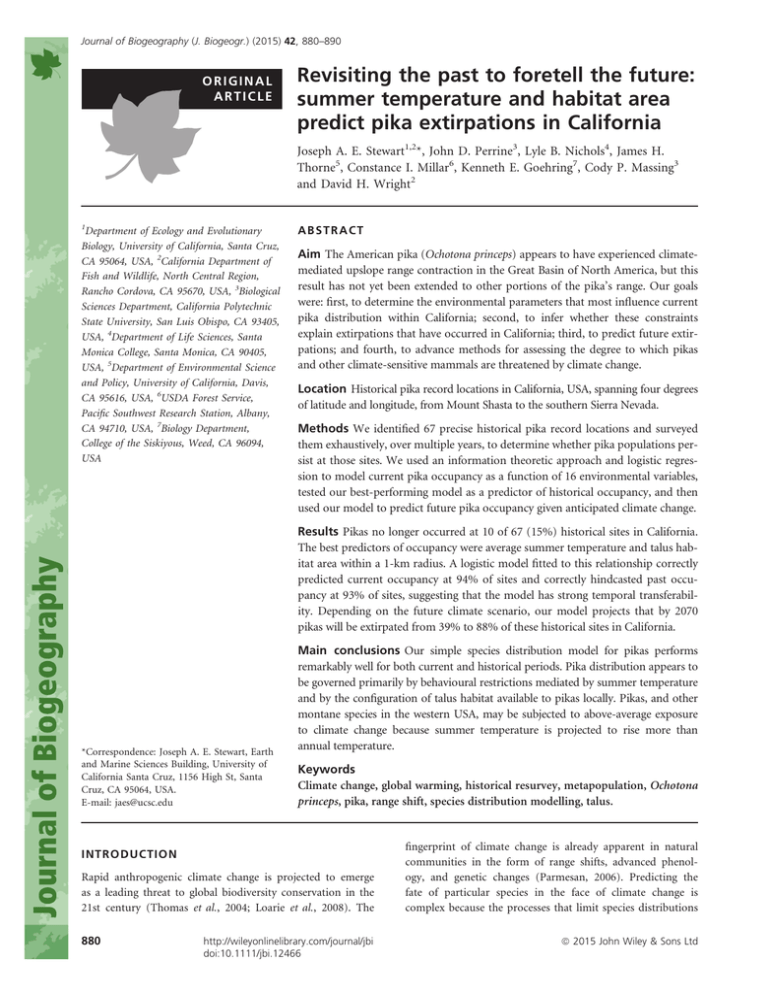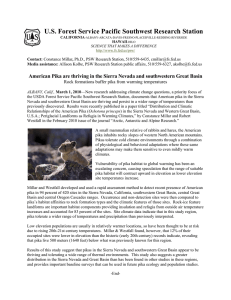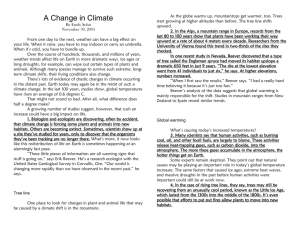Revisiting the past to foretell the future:
advertisement

Journal of Biogeography (J. Biogeogr.) (2015) 42, 880–890 ORIGINAL ARTICLE Revisiting the past to foretell the future: summer temperature and habitat area predict pika extirpations in California Joseph A. E. Stewart1,2*, John D. Perrine3, Lyle B. Nichols4, James H. Thorne5, Constance I. Millar6, Kenneth E. Goehring7, Cody P. Massing3 and David H. Wright2 1 Department of Ecology and Evolutionary Biology, University of California, Santa Cruz, CA 95064, USA, 2California Department of Fish and Wildlife, North Central Region, Rancho Cordova, CA 95670, USA, 3Biological Sciences Department, California Polytechnic State University, San Luis Obispo, CA 93405, USA, 4Department of Life Sciences, Santa Monica College, Santa Monica, CA 90405, USA, 5Department of Environmental Science and Policy, University of California, Davis, CA 95616, USA, 6USDA Forest Service, Pacific Southwest Research Station, Albany, CA 94710, USA, 7Biology Department, College of the Siskiyous, Weed, CA 96094, USA ABSTRACT Aim The American pika (Ochotona princeps) appears to have experienced climatemediated upslope range contraction in the Great Basin of North America, but this result has not yet been extended to other portions of the pika’s range. Our goals were: first, to determine the environmental parameters that most influence current pika distribution within California; second, to infer whether these constraints explain extirpations that have occurred in California; third, to predict future extirpations; and fourth, to advance methods for assessing the degree to which pikas and other climate-sensitive mammals are threatened by climate change. Location Historical pika record locations in California, USA, spanning four degrees of latitude and longitude, from Mount Shasta to the southern Sierra Nevada. Methods We identified 67 precise historical pika record locations and surveyed them exhaustively, over multiple years, to determine whether pika populations persist at those sites. We used an information theoretic approach and logistic regression to model current pika occupancy as a function of 16 environmental variables, tested our best-performing model as a predictor of historical occupancy, and then used our model to predict future pika occupancy given anticipated climate change. Results Pikas no longer occurred at 10 of 67 (15%) historical sites in California. The best predictors of occupancy were average summer temperature and talus habitat area within a 1-km radius. A logistic model fitted to this relationship correctly predicted current occupancy at 94% of sites and correctly hindcasted past occupancy at 93% of sites, suggesting that the model has strong temporal transferability. Depending on the future climate scenario, our model projects that by 2070 pikas will be extirpated from 39% to 88% of these historical sites in California. *Correspondence: Joseph A. E. Stewart, Earth and Marine Sciences Building, University of California Santa Cruz, 1156 High St, Santa Cruz, CA 95064, USA. E-mail: jaes@ucsc.edu Main conclusions Our simple species distribution model for pikas performs remarkably well for both current and historical periods. Pika distribution appears to be governed primarily by behavioural restrictions mediated by summer temperature and by the configuration of talus habitat available to pikas locally. Pikas, and other montane species in the western USA, may be subjected to above-average exposure to climate change because summer temperature is projected to rise more than annual temperature. Keywords Climate change, global warming, historical resurvey, metapopulation, Ochotona princeps, pika, range shift, species distribution modelling, talus. INTRODUCTION Rapid anthropogenic climate change is projected to emerge as a leading threat to global biodiversity conservation in the 21st century (Thomas et al., 2004; Loarie et al., 2008). The 880 http://wileyonlinelibrary.com/journal/jbi doi:10.1111/jbi.12466 fingerprint of climate change is already apparent in natural communities in the form of range shifts, advanced phenology, and genetic changes (Parmesan, 2006). Predicting the fate of particular species in the face of climate change is complex because the processes that limit species distributions ª 2015 John Wiley & Sons Ltd Pika resurveys in California and control abundances can shift over time or from one geographical region to another (Hijmans & Graham, 2006; Dobrowski et al., 2011; Santos et al., 2014). To make accurate predictions, it is necessary to show that species distribution models (SDMs) are transferable both temporally and geographically (Tuanmu et al., 2011; Blois et al., 2013). Mountain systems have inherent physical properties that both increase and decrease vulnerability of species to climate change. On the one hand, because climate gradients are relatively steep in complex topographic environments, montane species may be able to track their climate envelope by dispersing relatively short distances upslope (Loarie et al., 2009), or by exploiting topographic heterogeneity such as by shifting slope aspects. On the other hand, geographical isolation and unique environmental adaptations may make montane species especially vulnerable to warming (La Sorte & Jetz, 2010). As climate change forces range contractions, species may effectively be ‘pushed off’ the tops of mountains by warming climate (Thuiller et al., 2005). The American pika, Ochotona princeps (Richardson, 1828), a small (120–180 g), saxicolous lagomorph, has emerged as a model organism for examining the effects of climate change on montane species (Smith & Weston, 1990; Krijack, 2004; Beever et al., 2011). American pikas (henceforth referred to as pikas) may be especially vulnerable to climate warming because their lower elevational limit, at least in the southern part of their range, is relatively high with respect to other mammal species (McDonald & Brown, 1992; Moritz et al., 2008). In the Great Basin, pikas appear to be experiencing accelerating upslope range contraction in concert with regional warming (Beever et al., 2011). Further, SDM studies predict that pikas could suffer drastic range collapse and regional extinction across their range in western North America during the 21st century (Galbreath et al., 2009; Calkins et al., 2012). Because of this vulnerability, the species was petitioned for protection under the United States and California Endangered Species Acts (Wolf et al., 2007a,b). Despite acknowledging that climate change is expected to cause continued range loss, both petitions were denied on the basis that presently available scientific evidence does not indicate pikas are currently experiencing or will experience range-wide extinction within the foreseeable future. In their responses, both management agencies highlighted the need for more information on the degree to which pikas are threatened by climate change (United States Fish & Wildlife Service, 2010; California Department of Fish & Wildlife, 2013). Adaptations that allow pikas to survive in cold alpine climates make them poorly suited to warming temperatures. Low thermal conductance and high resting metabolic rate aid pikas in avoiding hypothermia during cold winters under the snow but make them vulnerable to hyperthermia in the summer (MacArthur & Wang, 1973; Smith, 1974). A key vulnerability is that their upper lethal body temperature is 3 °C above their resting body temperature (MacArthur & Journal of Biogeography 42, 880–890 ª 2015 John Wiley & Sons Ltd Wang, 1973; Smith & Weston, 1990). Thus, summer temperature may restrict pika distribution. To avoid acute heat stress during high temperatures, pikas thermoregulate behaviourally by reducing their foraging activity and spending more time in the cool interstices of talus fields where they reside (Smith, 1974). In contrast to many nonlagomorph small montane species, pikas do not hibernate or accumulate fat stores. Instead, during the summer they cache vegetation in haypiles on which they subsist during the winter (Smith & Weston, 1990). Reduced foraging and caching may result in reduced energy intake, reproduction, and survival (Smith, 1974). This same mechanism of range limitation – reduced foraging as a result of behavioural thermoregulation to avoid unsuitable temperatures – has been proposed as a common limitation for other montane mammals (Morelli et al., 2012) and animal species as a whole (P€ ortner, 2002). Resurvey results in the Great Basin support summer temperature as a top predictor of pika extirpations, but this result has not previously been generalized to other portions of the pika’s range (Moritz et al., 2008; Beever et al., 2011; Erb et al., 2011; Stewart & Wright, 2012). We used historical resurvey data from across the pika’s range in California to assess causes of pika extirpation, to infer whether climate change has led to upslope range contraction in California, and to build an SDM for projecting future occupancy. Two previous studies collected resurvey data on pikas within subregions of California, but both datasets suffered from small sample size and limited statistical power (Moritz et al., 2008; Stewart & Wright, 2012). We fitted a logistic model to current occupancy patterns, tested the model’s ability to hindcast known past occupancy based on past climate, and used the model to forecast future pika distribution. This study advances previous projections of future pika distribution (Galbreath et al., 2009; Calkins et al., 2012) in four respects. First, in contrast to previous approaches, which used ‘pseudo-absences’ from random locations across the landscape, our model is parameterized with verified, high-quality absence data. Second, we test our model for temporal transferability using historical occurrence data. Third, our model tests and incorporates a non-climate environmental variable (habitat area) into projections of future pika distribution. Finally, we use the most recent future climate projections from the Intergovernmental Panel on Climate Change (IPCC 5; Taylor et al., 2012). While our study focuses on the American pika, our methods and conclusions should be generalizable to other montane species, as we discuss below. MATERIALS AND METHODS Field methods and historical data We identified 67 historically recorded pika locations across the pika’s range in California from the 19th and 20th centuries, and resurveyed them to determine whether pikas have persisted at those sites. Our field methods were comparable 881 J. A. E. Stewart et al. to those of Stewart & Wright (2012) in the northern Sierra Nevada, with minor modifications. We surveyed each site until we had either detected pikas, or until we had completed an exhaustive search of all pika habitat within a 1-km radius of the historical location. If pikas or current-year pika sign were detected at a site, the site was scored as occupied. In addition to pika sightings or calls, haypiles or pika scat (sign) were considered recent evidence if they contained green hues from undecomposed chlorophyll. As a final measure, we listened for pika calls during morning and evening hours, when pikas are most active at hotter sites (Smith, 1974). We also searched for and collected older ‘relict’ pika faecal pellets to confirm past occupancy. Pika faecal pellets often persist for a decades after extirpation with gradual decline in size and change in colour (Nichols, 2010; see Appendix S1 in Supporting Information). We used a 1-km survey radius because it is large enough to detect large-scale metapopulation extirpations. Given the density of pika habitat in our region, exhaustive resurveys of a 1-km radius required up to 5 days of search effort. We aggregated data from six resurvey teams working in different regions of California (led by coauthors of this study). We endeavoured to include all reliable and spatially precise historical record locations that had been resurveyed prior to 2012. To obtain historical records, we queried biodiversity databases (accessed April 2011; Arctos: http://arctos.database.museum; CNDDB: http://www.dfg.ca.gov/ biogeodata/cnddb; GBIF: http://www.gbif.org/; and MaNIS: http://manisnet.org/), read field notes, visited offline museums, contacted professional networks, and searched the literature. Records accompanied by a voucher specimen or observed by an experienced researcher (e.g. Joseph Grinnell, Annie Alexander; Museum of Vertebrate Zoology, UC Berkeley) were considered reliable. Records were considered sufficiently precise only if all plausible interpretations of the historical description fit within a 1-km search radius (Appendix S1). The 67 records we resurveyed spanned the majority of the pika’s geographical and elevational range in the state. Records extended over more than four degrees of latitude and longitude, from the slopes of Mount Shasta in the north to the John Muir Wilderness in the south, and to the White Mountains in the east (Fig. 1, Appendix S1). The records covered an elevational range from the lowest known pika population in California (1380 m) to the high slopes of the southern Sierra (3940 m). Spatial uncertainty associated with historical records ranged from nil (detailed field notes accompanied by historical photographs; Appendix S1) to 1 km (e.g. museum skin with specimen tag specifying ‘east side of Pyramid Peak’) with a median precision of 0.4 km. The original observation year for records ranged from 1897 to 2000 (median = 1927), resurveys were conducted during 2004–2012 (median = 2010), and the interval between the historical observation and resurvey ranged from 12 to 109 years (median = 83). While 12 years may seem a relatively short interval for historical resurvey, our results 882 indicate it has been sufficiently long for populations to become extirpated. Pikas are highly detectable, based largely upon their frequent calls and copious and persistent faecal pellets. Previous studies indicate consistently high detection probability within discrete talus patches (> 90%) after 15–30 person-minutes (person-min) of search effort (Beever et al., 2010; Rodhouse et al., 2010; Erb et al., 2011; Jeffress et al., 2013). Extended to multiple talus patches within the 1-km radius, detection probability would approach certainty if three or more patches were occupied. We took several measures to maximize our confidence in observed extirpations. Depending on the amount of habitat, our search effort at extirpated sites ranged from 5 to 56 person-hours searching all talus (median = 11 person-hours) and 7 to 90 hours on site and within hearing distance of pika habitat (median = 24 person-hours). All sites where pikas were not initially detected during the first year were surveyed exhaustively in a subsequent year. Analytical methods and predictor variables We modelled pika persistence as a function of 16 environmental variables – 2 habitat, 2 elevation, and 12 climate variables – that capture the most biologically significant processes for pikas, as supported by a mechanistic hypothesis and/or by previously published literature (Appendix S2). These predictor variables were combined into 58 biologically informed a priori combinations and tested for predictive power. The 12 climate predictor variables were extracted from 270-m resolution grids, representing 10-year (2001– 2010) average climate surfaces from the California Basin Characterization Model (Daly et al., 1994; Flint & Flint, 2012; Thorne et al., 2012). Given that pikas can escape acute heat stress through behavioural thermoregulation and that they attain a maximum age of 7 years (Smith & Weston, 1990), we expected that full demographic collapse and extinction of a local metapopulation would typically be the result of multiple-year chronic climate effects as opposed to single-year acute effects. Climate variables included seasonal and annual temperature, precipitation, snowfall, snowpack depth, snowpack duration, climate water deficit (a drought index), and actual evapotranspiration (a vegetation productivity index). Elevation was included as a high spatial-resolution proxy for coarser resolution climate variables. Absolute elevation was extracted from 10-m resolution digital elevation models. Pika-equivalent elevation was calculated as the difference between absolute elevation and latitude–longitude calculated minimum elevation for pikas (Hafner, 1993). Values for each climate and elevation variable were extracted for the most suitable location within each site boundary (e.g. minimum average temperature within 1-km radius site, maximum elevation, maximum average precipitation, etc.). For each site, talus habitat was hand-delineated into a GIS layer using the best available aerial imagery (c. 3 person-hours spent on talus delineation per site) and total talus area and Journal of Biogeography 42, 880–890 ª 2015 John Wiley & Sons Ltd Pika resurveys in California Figure 1 Location and current occupancy status of 67 historical American pika (Ochotona princeps) sites in California. Background is coloured by average summer temperature. perimeter within the 1-km radius site boundary was calculated. Talus perimeter was included in addition to talus area because pikas may preferentially use edge habitat for access to forage (Moilanen et al., 1998; Millar, 2011; Jeffress et al., 2013). Two sites with anthropogenic pika habitat (ore dumps), where aerial talus mapping was not possible, were delineated on the ground. We evaluated the performance of the a priori models (Appendix S2) using logistic regression and multi-model inference techniques (Burnham & Anderson, 2002). Highly correlated variables (|r| > 0.7) and variables that attempted to measure similar causal mechanisms were not included in the same model (e.g. temperature and elevation were not included in the same model). To avoid over-fitting we restricted all models to a maximum of five events per variable (Vittinghoff & McCulloch, 2007). With a total of 10 extirpations (‘events’) in our data, this translated to no more than two predictor variables per model. To test whether our results were robust to imperfect detection, we performed simulations in which we iteratively reclassified one of 10 extirpated sites as occupied and evaluated the performance of our 58 a priori models. In addition to internal model evaluation we evaluated model performance using spatial and temporal cross-validation (Fielding & Bell, 1997; Wenger & Olden, 2012). First, we evaluated model performance in the current period using 10,000 iterations of randomly partitioned training (80%) and evaluation (20%) data (i.e. spatially distinct, temporally equivalent data; Kohavi, 1995). Journal of Biogeography 42, 880–890 ª 2015 John Wiley & Sons Ltd Next, we tested temporal transferability by training the model with the full set of current data and evaluating model performance using the full set of historical data (i.e. spatially equivalent, temporally distinct data; e.g. Boyce et al., 2002; Ara ujo et al., 2005; Moritz et al., 2008; Smith et al., 2013). Finally, we tested model transferability using data partitions that were both temporally and spatially distinct (Kharouba et al., 2009) – iteratively training the model with current data from 80% of sites and evaluating the model with historical data from the remaining 20% of sites. We projected pika occupancy for both historical and future climate conditions using the best-performing logistic model trained on current occupancy patterns. Sites with ≥ 50% predicted probability of occupancy were classified as occupied, and sites below this threshold were classified as unoccupied. We assumed no change in the amount of talus habitat at sites from the historical to future periods (1897– 2070). Historical climate for a given time period was calculated using the delta method and a 10-year running average of statewide deviations from current (2001–2010) climate (Abatzoglou et al., 2009; CCT 1895–2012). Downscaled Coupled Model Intercomparison Project Phase 5 (CMIP5, 2011) future climate change scenario surfaces, i.e. prepared for the IPCC’s 5th assessment report (Taylor et al., 2012), were obtained from the WorldClim database (30 arc-second resolution, c. 800 m grid cells; Hijmans et al., 2005), and further downscaled to 270 m to match current climate data resolution and baseline (delta method). We projected pika 883 J. A. E. Stewart et al. distribution during 2070 using one low emission and one high emission representative concentration pathway (RCP 4.5, ‘low,’ and RCP 8.5, ‘high’) combined with a low sensitivity (NASA Goddard Institute for Space Sciences model GISS-E2-R), high sensitivity (Atmosphere and Ocean Research Institute, University of Tokyo, National Institute for Environmental Studies, and Japan Agency for MarineEarth Science and Technology model MIROC-ESM) and ensemble mean general circulation model (mean of 17 GCMs), for a total of six future climate scenarios (Taylor et al., 2012). RESULTS Overall, 57 historically occupied sites were currently occupied by pikas (85%) and 10 sites were extirpated (15%). The average elevation of currently occupied sites (2800 m) was 500 m higher than the average elevation of extirpated sites (2300 m) (one-sided t-test, P = 0.009). We found old pika faeces, but no fresh sign, at all 10 extirpated sites, confirming previous site occupancy. Detection of old faeces was relatively easy at extirpated sites (median = 13, range = 5–59 person-min). Of the 10 extirpated sites, five occurred in the Lassen Transect, two occurred in the northern Sierra, and three occurred in the Bodie Hills (Fig. 1). For most occupied sites (81%) pika detection was easy, with pikas detected within 30 person-min (median = 5 person-min) and in the first talus patch surveyed. Pika detection was more difficult at nine of the occupied sites (median = 65 person-min, range 34–582 person-min). Five occupied sites where pikas were not detected during partial resurvey of the 1-km radius in the first year were discovered to be occupied during complete survey of the 1-km radius in a subsequent year. Occupied and extirpated sites did not differ statistically in year of their historical observation (median 1926 vs. 1931, respectively). The best-performing model, talus area + mean summer temperature, received considerably greater support than the next best-performing model (difference in corrected Akaike’s information criterion, ΔAICc = 2.39), 69% of the Akaike weight (wi) for all a priori models [area under the receiver operating characteristic curve (AUC) = 0.98; Table 1], and correctly classified current occupancy at 94% of sites (63/67; Fig. 2). The model performed nearly as well when cross-validated using partitioned, spatially distinct training and evaluation data [AUC = 0.95, 95% confidence interval, CI, (0.67, 1.00); percentage correctly predicted = 93%, 95% CI (77%, 100%)]. Relative support for the best model was more pronounced when models with climate-proxy variables (e.g. elevation) were excluded in order to extrapolate pika occupancy under past and future climate conditions (ΔAICc = 7.41, wi = 0.96). In simulations designed to test model robustness to imperfect detection probability, where one extirpated site was iteratively reclassified as occupied, the best-performing model (talus area + mean summer temperature) received the highest support in 9 of 10 simulations. 884 In the remaining simulation, talus area + mean summer temperature had the second highest support, and talus perimeter + mean summer temperature received the highest support. As a test for temporal transferability, we applied the best model to historical site temperature data to hindcast past occupancy at historical record locations. When evaluated against temporally distinct and spatially equivalent data, the model correctly hindcasted past occupancy during the year of the original observation at 93% of sites (62/67). When evaluated against temporally and spatially distinct data, the model correctly hindcasted 92% of sites, 95% CI (77%, 100%). Projecting to the future, our best-performing model predicted progressive site extirpations as summer temperatures warm. By 2070, overall extirpation at the 67 historical sites is projected to range from 39% to 88%, depending on the emissions pathway and the GCM used (Fig. 3, Appendix S2). Under ensemble mean GCM climate scenarios, the model projects that 51% to 75% of sites will no longer be occupied by pikas for the low and high emissions scenarios, respectively (RCP 4.5 and RCP 8.5). Extirpations at the historical localities are projected to be most pronounced in the northern Sierra (north of 38.5° latitude), the Lassen Transect, and the ranges east of the southern Sierra, where pikas were projected to disappear from 44% to 100% of these historical sites in these regions by 2070, over all future climate scenarios. However, even for the worst-case future climate scenario considered (MIROC-ESM, RCP 8.5), pikas are projected to persist through 2070 at some historical sites (at least 12% overall). Taking into account range-wide (i.e. beyond historical site) temperature projections (Rogelj et al., 2012), persistence past 2070 appears most likely in the high peaks of the Southern Sierra, the White Mountains, and Mount Shasta. DISCUSSION Two variables, talus area and mean summer temperature, did a very good job at separating sites where pikas are extant from sites where pikas have become extirpated since documented historical presence. Our best model, which incorporates these variables, strongly outperformed all other candidate models (Table 1), and correctly predicted current occupancy at 94% of sites (Fig. 2). The model performed nearly as well in a test of transferability through time – correctly predicting past occupancy at 93% of sites. This level of performance through historical time is high relative to models applied to other species, including other montane small mammals (Smith et al., 2013), butterflies (Kharouba et al., 2009), and plant species (Dobrowski et al., 2011). These same two variables, summer temperature and talus area, have strong mechanistic support, and have been repeatedly identified as the best predictors of pika occupancy elsewhere in the pika’s range, suggesting that our best-performing model may also be geographically transferable. Calkins et al. (2012) used Maxent (Phillips & Dudık, 2008) Journal of Biogeography 42, 880–890 ª 2015 John Wiley & Sons Ltd Pika resurveys in California Table 1 Performance and statistics of top models (ΔAICc ≤ 10) fitted to explain recent American pika (Ochotona princeps) persistence or extirpation relative to historical presence in California, USA; and of variables included in top models. Model ΔAICc AUC R2 wi Predictor wj wj/model TalArea + SumT TalArea + ElevEq TalArea + Elev TalArea + AnnT TalPerim + SumT TalPerim + ElevEq Null Model 0 2.39 4.57 7.41 8.02 9.92 35.81 0.98 0.97 0.97 0.94 0.95 0.94 0.5 0.79 0.76 0.72 0.68 0.67 0.64 0 0.69 0.21 0.07 0.02 0.01 0 0 SumT ElevEq TalArea Elev AnnT TalPerim 0.7 0.213 0.983 0.07 0.017 0.017 0.078 0.071 0.066 0.012 0.006 0.001 Sign + + + + CV 0.432 0.416 0.365 0.413 0.439 0.343 Left hand columns: models are listed in order of their difference from the best-performing model in corrected Akaike’s information criterion (ΔAICc). Climate predictors appear in bold. Column headings denote the area under the receiver operating characteristic curve (AUC), Nagelkerke’s max-scaled coefficient of determination (R2), and Akaike weights among all a priori models (wi). Right hand columns: column headings denote Akaike weights among all 58 a prior models (wj), Akaike weights per model (wj/model), the sign of fitted variable coefficients (Sign), and the coefficient of variation across all fitted coefficient values (CV). Variables are listed in order of decreasing weight per model. Coefficient signs (indicating a positive or negative relationship with occupancy) were consistent in all models and for all variables. Variable abbreviations are as follows: SumT, summer temperature; TalArea, talus area; ElevEq, pika-equivalent elevation; AnnT, annual temperature; Elev, elevation; TalPerim, talus perimeter. More information on variable definitions can be found in the text and in Appendix S2. Figure 2 Current status of American pika (Ochotona princeps) occupancy at 67 historical pika record locations in California plotted against the best predictor variables, talus area and mean summer temperature. The central dashed grey line represents a 50% probability of occupancy as modelled by logistic regression, while the outer dashed lines represent 95% and 5% probability of occupancy. and stepwise variable selection to identify mean summer temperature from a candidate set of 19 bioclimatic variables as the best predictor of pika distribution across the contiguous western USA. Two historical resurvey studies in the Great Basin indicated that mean summer temperature was the strongest limiting factor for pikas (Beever et al., 2010, 2011). As a mechanistic hypothesis, mean summer temperature is supported as a factor limiting foraging as a result of behavioural thermoregulation. This mechanism is reinforced by knowledge of the pika’s natural history (Smith & Weston, 1990), behavioural observations of reduced activity during Journal of Biogeography 42, 880–890 ª 2015 John Wiley & Sons Ltd high ambient temperatures (MacArthur & Wang, 1974; Smith, 1974), and physiological studies indicating very limited ability to dissipate heat and avoid hyperthermia (MacArthur & Wang, 1973). Mean summer temperature appears to regulate viability of low-elevation populations because it closely reflects conditions during crepuscular hours. The importance of crepuscular temperature to low-elevation sites is evidenced by the observed transition from diurnal activity at cold sites, to more-restricted crepuscular activity at warm sites, and ultimately to extirpation at the warmest sites (Smith, 1974; J.A.E.S., pers. obs.). Finally, temperature is supported as a limiting constraint by the palaeontological record of upslope range retreat by pikas since the Last Glacial Maximum (Grayson, 2005). Talus area – the amount of habitat available to pikas locally – has also been previously identified as a factor affecting population and metapopulation dynamics (MacArthur & Wilson, 1967; Moilanen et al., 1998) and has been documented in other pika extirpation studies in the Great Basin (Beever et al., 2003, 2011) and in a subset of the California records (Stewart & Wright, 2012). Given that pikas preferentially use talus-edge habitat, with access to vegetation on which they feed (Moilanen et al., 1998; Millar, 2011; Jeffress et al., 2013), it is interesting that, in this study, talus area emerged as a better predictor of pika occupancy than talus perimeter. Talus area may be a more relevant measure of habitat availability because vegetation is often present in small patches within talus fields that are not reflected in talus perimeter measurements. Low talus area within a 1-km radius is generally indicative both of small habitat islands and poor connectivity between talus patches. Increased temperatures may compound poor habitat connectivity by impeding the survival of dispersing pikas (Smith, 1974). The precise mechanism behind the apparent relationship between talus area and site persistence is not known, but reasonable hypotheses include the following: (1) larger populations are less vulnerable to stochastic extinction (MacArthur & Wilson, 1967); (2) sites 885 J. A. E. Stewart et al. Figure 3 Predicted American pika (Ochotona princeps) occupancy status mapped at historical sites in California for 2070 under six future climate scenarios. Blue circles denote occupied sites while red crosses denote extirpated sites. Climate change scenarios (six panels) combine two representative concentration pathways, RCP, (low emission: RCP 4.5, high emission: RCP 8.5) with a low sensitivity general circulation model, GCM, (GISS-E2-R), a high sensitivity GCM (MIROC-ESM), and the ensemble mean of 17 GCMs. See also Appendices S2 & S3. with more talus have better connectivity with higher elevation talus patches; and (3) sites with more habitat available are more likely to contain refugial areas with more suitable mesoclimate (Millar & Westfall, 2010). In this analysis, we used a conservative criterion – complete absence of any current-year pika sign within a 1-km radius – to score sites as occupied or extirpated. We adopted this definition to differentiate landscape-level extirpations (on which this study focuses) from patch-scale metapopulation fluctuations, and to accommodate inclusion of records with moderately precise record descriptions. It is important to note that this definition glosses over interesting dynamics within sites. Four of our occupied sites appeared, anecdotally, to be sink habitats, i.e. sites that receive dispersers from nearby source patches and that do not currently sustain reproducing populations (Holt, 1985). At these sites, old pika 886 faeces were widespread, but evidence of current occupancy was scant (≤ 2 individuals observed in any year), and search effort necessary for first detection of current occupancy was high (median = 356 person-min. searching talus). Two of these sites may have been very recently re-extirpated, as fresh pika sign was observed (green pellets and haypiles), but extensive late-summer surveys during morning and evening hours did not result in direct detection (sightings or hearing calls). At another site, a total of three pikas were observed during three years of extensive search effort, but no individual talus patch was ever occupied for two consecutive years. At the fourth site, we observed evidence of only two pikas (one direct sighting) and evidence of current occupancy had retreated upslope by c. 300 m elevation from the historical record. We suggest that juvenile pikas are able to disperse to these sites from nearby higher elevation habitat, but are not Journal of Biogeography 42, 880–890 ª 2015 John Wiley & Sons Ltd Pika resurveys in California able to re-establish self-sustaining populations. Although we treated these sites as occupied in our analysis, our qualitative conclusions (i.e. talus area and summer temperature was the most informative model) are robust to treating these sites as either occupied or extirpated. Using our best-performing model, the probability of occupancy at our sink habitat sites was significantly lower than at occupied sites (one-sided Wilcoxon test, P = 0.020) and significantly higher than at extirpated sites (one-sided Wilcoxon test, P = 0.012). Our results, coupled with the documented c. 1 °C increases in California-wide summer temperature over the past century (California Climate Tracker, 1895–2012; Abatzoglou et al., 2009), strongly suggest that pikas have experienced climate-mediated range contraction in California over the past century. Because historical absence data for pikas is limited, definitive conclusions are not possible at this point. An alternative hypothesis is that all extirpations are the temporary result of normal metapopulation dynamics, and that the statistical relationship between temperature and pika extirpation (which has now been documented in both California and the Great Basin) exists because of more tenuous demographic conditions and higher turnover in patch occupancy near the lower boundary of the pika’s elevation range, although not caused by temperature. Under the ‘no climate effect hypothesis’ we would expect that, in the intervening years since the historical era, an equivalent number of historical sites would have been colonized as were extirpated. As we were only able to identify one site where pikas were observed to be historically absent (recorded by Joseph Grinnell; still not occupied by pikas) we are not able to draw conclusions about recolonization. However, we observed apparently unsuccessful recolonization (e.g. dispersal followed by mortality) at four low-elevation ‘sink-habitat’ sites that are marginal in temperature and talus conditions, suggesting that previously occupied low-elevation sites have become unsuitable. Using future temperature projections for 2070, and our statistical model of extirpation in relation to summer temperature and habitat area, we projected extensive (39%) to dramatic (88%) extirpation among our sites (Fig. 3, Appendix S2 & S3). Appendix S3 presents a graphical animation of the model results projecting pika occupancy through time as climate change becomes more severe: sites ‘march’ towards higher temperatures and eventually pass out of the threshold of pika viability. We offer three important caveats to these projections. First, historical sites are not a random sample of the pika’s entire distribution throughout California, and thus our projections are not interpretable as a range-wide estimate of range contraction but apply only to these historical sites. A critical step in applying our model to broader scales will be mapping talus distribution for entire regions. GIS algorithms that accurately automate talus mapping would represent an invaluable contribution towards this effort. Second, the performance and transferability of SDMs is dependent on the models taking into account the full range of important Journal of Biogeography 42, 880–890 ª 2015 John Wiley & Sons Ltd climate and non-climate environmental variables (Duncan et al., 2009). Our small number of events (10 extirpations) limits our statistical ability to estimate parameters for more than two predictor variables in a model. While it appears that summer temperature and talus area are two of the most important limiting factors to pika distribution, other variables and variable interactions (e.g. hydrology) undoubtedly also play a role (Beever et al., 2010; Erb et al., 2011; Jeffress et al., 2013). Third, for sites with high talus area (i.e. upper quartile), our dataset lacks extirpations, and thus model projection must extrapolate the temperature threshold for presence–absence at these sites (Fig. 2). For the highest talus area sites, the resulting projection predicts that pikas will persist through summer temperatures above the range of temperatures that pikas currently inhabit throughout their range (VertNet pika records 1970–present, n = 1852). We therefore suspect our model, uncritically applied, may underestimate extirpation at sites with high talus area. That the American pika’s distribution is tied to mean summer temperature does not bode well for the future of the species, especially because there is a near-consensus among climate models (16 of 17 GCMs) that summer temperature will warm by more than mean annual temperatures in the western USA (IPCC 5; Taylor et al., 2012). This trend is also apparent in the historical instrumental record for California (California Climate Tracker, 1895–2012; Abatzoglou et al., 2009). For sites in this study, summer temperature is projected to rise by 0.9 °C more on average than annual temperature (RCP 8.5, 2070). This may indicate that in the western USA, pikas and other species that are primarily active during the summer (e.g. most high-elevation species) will have higher seasonal exposure to climate change. Our results should therefore be a call for greater monitoring of high-elevation species throughout the western USA. Our projection of particularly drastic, imminent, extirpation in northern California and east of the southern Sierra is concordant with two previous SDM projections (Galbreath et al., 2009; Calkins et al., 2012) which used presence-only data. Because pikas are already restricted to the highest elevations throughout much of these regions, climate change is poised to push their lower elevational limit higher than the range of available habitat in many areas. In contrast, most GCMs predict that temperatures in the highest peaks of the southern Sierra (Rogelj et al., 2012) will remain suitable for pikas through the end of the 21st century. Two other notable ‘sky islands’ in California, where pikas could become restricted to the highest elevations by the end of the century, are Mount Shasta and the White Mountains. ACKNOWLEDGEMENTS Access to museum records and specimens was facilitated by C. Conroy and J. Patton, University of California Berkeley Museum of Vertebrate Zoology; I. Engilis, University of California Davis Museum of Wildlife and Fish Biology; and D. Castronovo, California Academy of Sciences. Additional 887 J. A. E. Stewart et al. historical sites were identified through correspondence with A. Smith, C. Ray and J. Patton. We thank many field assistants – J. Boulat, K. Graham, J. N. Henderson, S. Huskins, K. Leviste, C. Nguyen, P. Nichols, R. Pauloo, T. Rosenthal, S. Stewart, K. Wiggins and M. Wilder. Funding for northcentral California surveys was provided by a US Fish and Wildlife Service, State Wildlife Grant to the California Department of Fish and Wildlife. REFERENCES Abatzoglou, J.T., Redmond, K.T. & Edwards, L.M. (2009) Classification of regional climate variability in the state of California. Journal of Applied Meteorology and Climatology, 48, 1527–1541. Ara ujo, M.B., Pearson, R., Thuiller, W. & Erhard, M. (2005) Validation of species–climate impact models under climate change. Global Change Biology, 11, 1504–1513. Beever, E.A., Brussard, P.F. & Berger, J. (2003) Patterns of apparent extirpation among isolated populations of pikas (Ochotona princeps) in the Great Basin. Journal of Mammalogy, 84, 37–54. Beever, E.A., Ray, C., Mote, P.W. & Wilkening, J.L. (2010) Testing alternative models of climate-mediated extirpations. Ecological Applications, 20, 164–178. Beever, E.A., Ray, C., Wilkening, J.L., Brussard, P.F. & Mote, P.W. (2011) Contemporary climate change alters the pace and drivers of extinction. Global Change Biology, 17, 2054–2070. Blois, J.L., Williams, J.W., Fitzpatrick, M.C., Jackson, S.T. & Ferrier, S. (2013) Space can substitute for time in predicting climate-change effects on biodiversity. Proceedings of the National Academy of Sciences USA, 110, 9374–9379. Boyce, M., Vernier, P., Nielsen, S. & Schmiegelow, F. (2002) Evaluating resource selection functions. Ecological Modelling, 157, 281–300. Burnham, K.P. & Anderson, D.R. (2002) Model selection and multimodel inference: a practical information-theoretic approach. Springer, New York. California Climate Tracker (1895–2012) Mean summer temperature, statewide. Western Regional Climate Center, Reno, NV. Available at: http://www.wrcc.dri.edu/monitor/ cal-mon/frames_version.html (accessed 20 December 2012). California Department of Fish and Wildlife (2013) Status review of the American pika (Ochotona princeps) in California. Sacramento, CA. Calkins, M.T., Beever, E.A., Boykin, K.G., Frey, J.K. & Andersen, M.C. (2012) Not-so-splendid isolation: modeling climate-mediated range collapse of a montane mammal Ochotona princeps across numerous ecoregions. Ecography, 35, 780–791. CMIP5 (2011) WCRP Coupled Model Intercomparison Project – Phase 5 – CMIP5. Special Issue of the CLIVAR Exchanges Newsletter, No. 56, Vol. 16, No. 2, 1–52. Daly, C., Neilson, R.P. & Phillips, D.L. (1994) A statisticaltopographic model for mapping climatological precipitation 888 over mountainous terrain. Jounral of Applied Meteorology, 33, 140–158. Dobrowski, S.Z., Thorne, J.H., Greenberg, J.A., Safford, H.D., Mynsberge, A.R., Crimmins, S.M. & Swanson, A.K. (2011) Modeling plant distributions over 75 years of measured climate change in California, USA: relating temporal transferability to species traits. Ecological Monographs, 81, 241–257. Duncan, R.P., Cassey, P. & Blackburn, T.M. (2009) Do climate envelope models transfer? A manipulative test using dung beetle introductions. Proceedings of the Royal Society B: Biological Sciences, 276, 1449–1457. Erb, L.P., Ray, C. & Guralnick, R. (2011) On the generality of a climate-mediated shift in the distribution of the American pika (Ochotona princeps). Ecology, 92, 1730– 1735. Fielding, A.H. & Bell, J.F. (1997) A review of methods for the assessment of prediction errors in conservation presence/ absence models. Environmental Conservation, 24, 38–49. Flint, L.E. & Flint, A.L. (2012) Downscaling future climate scenarios to fine scales for hydrologic and ecological modeling and analysis. Ecological Processes, 1, 2. Galbreath, K.E., Hafner, D.J. & Zamudio, K.R. (2009) When cold is better: climate-driven shifts yield complex patterns of diversification and demography in an alpine specialist (American pika, Ochotona princeps). Evolution, 63, 2848– 2863. Grayson, D.K. (2005) A brief history of Great Basin pikas. Journal of Biogeography, 32, 2103–2111. Hafner, D.J. (1993) North American pika (Ochotona princeps) as a late Quaternary biogeographic indicator species. Quaternary Research, 39, 373–380. Hijmans, R.J. & Graham, C.H. (2006) The ability of climate envelope models to predict the effect of climate change on species distributions. Global Change Biology, 12, 2272– 2281. Hijmans, R.J., Cameron, S.E., Parra, J.L., Jones, P.G. & Jarvis, A. (2005) Very high resolution interpolated climate surfaces for global land areas. International Journal of Climatology, 25, 1965–1978. Holt, R.D. (1985) Population dynamics in two-patch environments: some anomalous consequences of an optimal habitat distribution. Theoretical Population Biology, 28, 181–208. Jeffress, M.R., Rodhouse, T.J., Ray, C., Wolff, S. & Epps, C.W. (2013) The idiosyncrasies of place: geographic variation in the climate–distribution relationships of the American pika. Ecological Applications, 23, 864–878. Kharouba, H.M., Algar, A.C. & Kerr, J.T. (2009) Historically calibrated predictions of butterfly species’ range shift using global change as a pseudo-experiment. Ecology, 90, 2213– 2222. Kohavi, R. (1995) A study of cross-validation and bootstrap for accuracy estimation and model selection. International Joint Conference on Artificial Intelligence. Montreal, Quebec, Canada. Journal of Biogeography 42, 880–890 ª 2015 John Wiley & Sons Ltd Pika resurveys in California Krijack, K. (2004) All downhill from here? Science, 303, 1600–1602. La Sorte, F.A. & Jetz, W. (2010) Projected range contractions of montane biodiversity under global warming. Proceedings of the Royal Society B: Biological Sciences, 277, 3401–3410. Loarie, S.R., Carter, B.E., Hayhoe, K., McMahon, S., Moe, R., Knight, C.A. & Ackerly, D.D. (2008) Climate change and the future of California’s endemic flora. PLoS ONE, 3, e2502. Loarie, S.R., Duffy, P.B., Hamilton, H., Asner, G.P., Field, C.B. & Ackerly, D.D. (2009) The velocity of climate change. Nature, 462, 1052–1055. MacArthur, R.A. & Wang, L.C.H. (1973) Physiology of thermoregulation in the pika. Canadian Journal of Zoology, 51, 11–16. MacArthur, R.A. & Wang, L.C.H. (1974) Behavioral thermoregulation in the pika Ochotona princeps: a field study using radiotelemetry. Canadian Journal of Zoology, 52, 353–358. MacArthur, R.H. & Wilson, E.O. (1967) The theory of island biogeography. Princeton University Press, Princeton, NJ. McDonald, K.A. & Brown, J.H. (1992) Using montane mammals to model extinctions due to global change. Conservation Biology, 6, 409–415. Millar, C.I. (2011) Influence of domestic livestock grazing on American pika (Ochotona princeps) haypiling behavior in the eastern Sierra Nevada and Great Basin. Western North American Naturalist, 71, 425–430. Millar, C.I. & Westfall, R.D. (2010) Distribution and climatic relationships of the American pika (Ochotona princeps) in the Sierra Nevada and western Great Basin, U.S.A.; periglacial landforms as refugia in warming climates. Arctic, Antarctic, and Alpine Research, 42, 76–88. Moilanen, A., Smith, A.T. & Hanski, I. (1998) Long-term dynamics in a metapopulation of the American pika. The American Naturalist, 152, 530–542. Morelli, T.L., Smith, A.B., Kastely, C.R., Mastroserio, I., Moritz, C. & Beissinger, S.R. (2012) Anthropogenic refugia ameliorate the severe climate-related decline of a montane mammal along its trailing edge. Proceedings of the Royal Society B: Biological Sciences, 279, 4279–4286. Moritz, C., Patton, J.L., Conroy, C.J., Parra, J.L., White, G.C. & Beissinger, S.R. (2008) Impact of a century of climate change on small-mammal communities in Yosemite National Park, USA. Science, 322, 261–624. Nichols, L.B. (2010) Fecal pellets of American pikas (Ochotona princeps) provide a crude chronomoeter for dating patch occupancy. Western North American Naturalist, 70, 500–507. Parmesan, C. (2006) Ecological and evolutionary responses to recent climate change. Annual Review of Ecology, Evolution, and Systematics, 37, 637–669. Phillips, S.J. & Dudık, M. (2008) Modeling of species distributions with Maxent: new extensions and a comprehensive evaluation. Ecography, 31, 161–175. Journal of Biogeography 42, 880–890 ª 2015 John Wiley & Sons Ltd P€ ortner, H.O. (2002) Climate variations and the physiological basis of temperature dependent biogeography: systemic to molecular hierarchy of thermal tolerance in animals. Comparative Biochemistry and Physiology. Part A, 132, 739–761. Rodhouse, T.J., Beever, E.A., Garrett, L.K., Irvine, K.M., Jeffress, M.R., Munts, M. & Ray, C. (2010) Distribution of American pikas in a low-elevation lava landscape: conservation implications from the range periphery. Journal of Mammalogy, 91, 1287–1299. Rogelj, J., Meinshausen, M. & Knutti, R. (2012) Global warming under old and new scenarios using IPCC climate sensativity range estimates. Nature Climate Change, 2, 248–253. Santos, M.J., Thorne, J.H. & Moritz, C. (2014) Synchronicity in elevation range shifts among small mammal and vegetation over the last century is stronger for omnivores. Ecography, doi:10.1111/ecog.00931. Smith, A.T. (1974) The distribution and dispersal of pikas: influences of behavior and climate. Ecology, 55, 1368–1376. Smith, A.T. & Weston, M.L. (1990) Ochotona princeps. Mammalian Species, 352, 1–8. Smith, A.B., Santos, M.J., Koo, M.S., Rowe, K.M.C., Rowe, K.C., Patton, J.L., Perrine, J.D., Beissinger, S.R. & Moritz, C. (2013) Evaluation of species distribution models by resampling of sites surveyed a century ago by Joseph Grinnell. Ecography, 36, 1017–1031. Stewart, J.A.E. & Wright, D.H. (2012) Assessing persistence of the American pika at historic localities in California’s northern Sierra Nevada. Wildlife Society Bulletin, 36, 759–764. Taylor, K.E., Stouffer, R.J. & Meehl, G.A. (2012) An overview of CMIP5 and the experiment design. Bulletin of the American Meteorological Society, 93, 485–498. Thomas, C.D., Cameron, A., Green, R.E., Bakkenes, M., Beaumont, L.J., Collingham, Y.C., Erasmus, B.F.N., de Siqueira, M.F., Grainger, A., Hannah, L., Hughes, L., Huntley, B., van Jaarsveld, A.S., Midgley, G.F., Miles, L., Ortega-Huerta, M.A., Peterson, A.T., Phillips, O.L. & Williams, S.E. (2004) Extinction risk from climate change. Nature, 427, 145–148. Thorne, J.H., Boynton, R., Flint, L., Flint, A. & N’goc Le, T. (2012) Development and application of downscaled hydroclimatic predictor variables for use in climate vulnerability and assesment studies. A White Paper from the California Energy Commission’s California Climate Change Center. PIER Report. Publication no. CEC-500-2012-010. University of California, Davis, CA. Thuiller, W., Lavorel, S., Ara ujo, M.B., Sykes, M.T. & Prentice, I.C. (2005) Climate change threats to plant diversity in Europe. Proceedings of the National Academy of Sciences USA, 102, 8245–8250. Tuanmu, M.-N., Vi~ na, A., Roloff, G., Liu, W., Ouyang, Z., Zhang, H. & Liu, J. (2011) Temporal transferability of wildlife habitat models: implications for habitat monitoring. Journal of Biogeography, 38, 1510–1523. 889 J. A. E. Stewart et al. United States Fish and Wildlife Service (2010) 12-month finding on a petition to list the American pika as threatened or endangered. Federal Register, 75, 6437–6471. Vittinghoff, E. & McCulloch, C.E. (2007) Relaxing the rule of ten events per variable in logistic and Cox regression. American Journal of Epidemiology, 165, 710–718. Wenger, S. & Olden, J. (2012) Assessing transferability of ecological models: an underappreciated aspect of statistical validation. Methods in Ecology and Evolution, 3, 260–267. Wolf, S.G., Nowicki, B. & Siegel, K. (2007a) Petition to list the American pika (Ochotona princeps) as threatened under the California Endangered Speces Act. Center for Biological Diversity, San Francisco, CA. Wolf, S.G., Nowicki, B. & Siegel, K. (2007b) Petition to list the American pika (Ochotona princeps) as threatened under the United States Endangered Species Act. Center for Biological Diversity, San Francisco, CA. SUPPORTING INFORMATION Additional Supporting Information may be found in the online version of this article: Appendix S1 Field methods and site locations. Appendix S2 Predictor variables, candidate models, and model results. 890 Appendix S3 Animation of projected future fate of pika at 67 sites in California, USA. BIOSKETCH Joseph Stewart is a graduate student researcher at the University of California Santa Cruz and a Scientific Aide at the California Department of Fish and Wildlife. His research focuses on biodiversity conservation and climate change, with recent focus on the American pika, high-elevation communities, and the blunt-nosed leopard lizard (Gambelia sila). He grew up spending time each summer backpacking in California’s Sierra Nevada Mountains with his father. He recently completed a M.S. degree at the University of Nevada Reno. Author contributions: J.A.E.S., D.H.W. and J.D.P. conceived the study design; J.A.E.S, J.D.P., L.B.N., C.I.M., K.E.G., C.P.M. and D.H.W. resurveyed historical sites; J.A.E.S. and D.H.W. performed the statistical analysis and modelling; J.A.E.S. led the writing; D.H.W., J.D.P., C.I.M. and J.H.T. contributed to the writing. Editor: Brett Riddle Journal of Biogeography 42, 880–890 ª 2015 John Wiley & Sons Ltd







